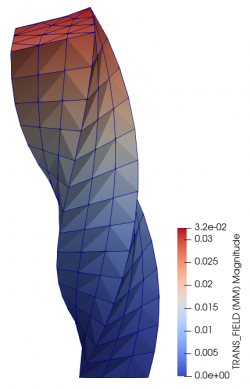WE6 SOLID-ISOPARAM element twisted beam validation
This validation aims at assessing the behavior of the SesamX WE6 SOLID-ISOPARAM element against the equivalent Abaqus C3D6 element. Both elements implement the iso-parametric formulation. However the stiffness integration is not performed the same: SesamX uses the exact 6-point Gaussian integration scheme, whereas Abaqus uses the reduced 2-point Gaussian integration scheme. Using a reduced integration scheme is beneficial to reduce element locking. However, it also makes the element unstable: it introduces a zero-energy mode in the element. Practice has shown that this mode disappears once an assembly of C3D6 element is built. At the opposite, in SesamX we chose to stay safe and avoid exposing an unstable element to the user.
As such, we expect the SesamX element to be stiffer than the Abaqus element.
Validation model
A twisted 3D beam model is studied for this comparison.

The beam is clamped at one end and subjected to an arbitrary load at the other end. A linear elastic material is applied with $E = 200 GPa$ and $\nu = 0.33$.
This case is solved as a linear static resolution.
Validation results
The following figure gives an overview of the beam displacement.

The following table gives the comparison of the nodal translations between Abaqus and SesamX.
| Abaqus | SesamX | Comparison | |||||||
|---|---|---|---|---|---|---|---|---|---|
| Node id | $u_x (m)$ | $u_y (m)$ | $u_z (m)$ | Magnitude $(m)$ | $u_x (m)$ | $u_y (m)$ | $u_z (m)$ | Magnitude $(m)$ | Magnitude error |
| 1 | 8.49E-32 | 8.23E-32 | -2.05E-31 | 2.37E-31 | 0.00E+00 | 0.00E+00 | 0.00E+00 | 0.00E+00 | - |
| 50 | 1.96E-07 | 9.85E-07 | -6.68E-07 | 1.21E-06 | 1.83E-07 | 8.99E-07 | -5.99E-07 | 1.10E-06 | -9.14% |
| 100 | 1.72E-06 | 4.92E-06 | 1.34E-06 | 5.38E-06 | 1.63E-06 | 4.46E-06 | 1.23E-06 | 4.91E-06 | -8.74% |
| 150 | 2.97E-06 | 1.21E-05 | -8.47E-07 | 1.25E-05 | 2.81E-06 | 1.10E-05 | -7.58E-07 | 1.14E-05 | -8.79% |
| 200 | 5.64E-06 | 2.05E-05 | 2.07E-06 | 2.14E-05 | 5.29E-06 | 1.87E-05 | 1.91E-06 | 1.95E-05 | -8.75% |
| 240 | 8.94E-06 | 3.40E-05 | 6.00E-06 | 3.56E-05 | 8.36E-06 | 3.09E-05 | 5.26E-06 | 3.25E-05 | -8.88% |
The maximum difference is about 10%. And as expected the SesamX element is stiffer than the Abaqus element.
The following table gives the comparison of the principal strains between Abaqus and SesamX.
| Abaqus | SesamX | Comparison | |||||||
|---|---|---|---|---|---|---|---|---|---|
| Element id | $\varepsilon_{11} (\%)$ | $\varepsilon_{22} (\%)$ | $\varepsilon_{33} (\%)$ | $\varepsilon_{11} (\%)$ | $\varepsilon_{22} (\%)$ | $\varepsilon_{33} (\%)$ | $\varepsilon_{11}$ error | $\varepsilon_{22}$ error | $\varepsilon_{33}$ error |
| 7 | 8.53E-06 | -1.44E-06 | -2.12E-06 | 7.76E-06 | -1.27E-06 | -1.93E-06 | -9.09% | -11.51% | -8.86% |
| 198 | 1.05E-06 | 5.18E-07 | -2.42E-06 | 9.13E-07 | 4.75E-07 | -2.15E-06 | -12.96% | -8.22% | -11.21% |
| 279 | 1.01E-05 | 1.61E-07 | -8.36E-06 | 8.40E-06 | 2.13E-07 | -7.50E-06 | -16.98% | 32.80% | -10.37% |
Over significant values, the maximum difference is about 17%. The results obtained are coherent with the displacements.
The following table gives the comparison of the principal stresses between Abaqus and SesamX.
| Abaqus | SesamX | Comparison | |||||||
|---|---|---|---|---|---|---|---|---|---|
| Element id | $\sigma_{11} (MPa)$ | $\sigma_{22} (MPa)$ | $\sigma_{33} (MPa)$ | $\sigma_{11} (MPa)$ | $\sigma_{22} (MPa)$ | $\sigma_{33} (MPa)$ | $\sigma_{11}$ error | $\sigma_{22}$ error | $\sigma_{33}$ error |
| 7 | 2.01E-02 | 5.11E-03 | 4.09E-03 | 1.83E-02 | 4.74E-03 | 3.75E-03 | -8.87% | -7.21% | -8.19% |
| 198 | 3.38E-04 | -4.61E-04 | -4.87E-03 | 2.68E-04 | -3.90E-04 | -4.33E-03 | -20.59% | -15.37% | -11.13% |
| 279 | 1.80E-02 | 3.03E-03 | -9.79E-03 | 1.43E-02 | 1.95E-03 | -9.65E-03 | -20.82% | -35.79% | -1.43% |
Over significant values, the maximum difference is about 21%. The results obtained are coherent with the displacements.